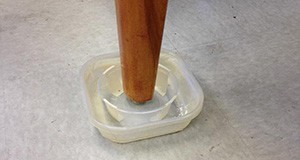Abstract
Many types of traps can be used to monitor or control insect pests. Traps to capture insects vary greatly, depending on the target, location, and purpose. Traps may be inexpensive and disposable, or more complex. This 12-page fact sheet describes several traps for common pests in the home, garden, and landscape that can be made using common household materials or that are readily available in stores. Written by Steven Arthurs and Adrian Hunsberger, and published by the Entomology and Nematology Department, December 2015.
References
Aigner, J. D., and T. P. Kuhar. 2014. "Using citizen scientists to evaluate light traps for catching brown marmorated stink bugs in homes in Virginia." Journal of Extension 52(4): Article # 4RIB5
Dreistadt, S. H., and M. L. Flint. 1995. "Landscape pest monitoring methods and training managers to use them." Journal of Arboriculture 21(1): 1-6.
Epsky, N. D., W. L. Morrill, and R. W. Mankin. 2008. "Traps for Capturing Insects." Encyclopedia of Entomology (Ed. Capinera JL.), Springer, pp 3887-3901.
Hottel, B. A., R. W. Baldwin, R. M. Pereira, and P. G. Koehler. 2014. How to make a bed bug interceptor trap out of common household items. ENY-2029. Gainesville: University of Florida Institute of Food and Agricultural Sciences. http://edis.ifas.ufl.edu/in1022 (31 January 2015)
Hulcr, J. and N. McCoy. 2013. Catching Beetles. How do I trap ambrosia and bark beetles? Use the Bambara Beetle Trap! Ambrosia Symbiosis. http://www.ambrosiasymbiosis.org/ambrosia-beetles/catching-beetles/ (accessed 24 Sept. 2018)
Klostermeyer, L. E. 1985. "Japanese beetle (Coleoptera: Scarabaeidae) traps: Comparison of commercial and homemade traps." Journal of Economic Entomology, 78(2): 454-459. https://doi.org/10.1093/jee/78.2.454
Lindgren, B. S. 1983. "A multiple funnel trap for scolytid beetles (Coleoptera)." The Canadian Entomologist, 115, 299-302. https://doi.org/10.4039/Ent115299-3
Mizell, III, R. F., R. F. Mizell, and R. A. Mizell. 2002. "Trolling: A novel trapping method for Chrysops spp. (Diptera: Tabanidae)." Florida Entomologist, 85(2): 356-366. https://doi.org/10.1653/0015-4040(2002)085[0356:TANTMF]2.0.CO;2
Ogg, B. n.d. Do-It-Yourself Bed Bug Trap. University of Nebraska Lincoln Extension publication 338. http://lancaster.unl.edu/pest/resources/338bedbugtrap.pdf (4 February 2015)
Squitter, J. M. 1998 (revised 2014). Deer flies, yellow flies and horse flies: Chrysops, Diachlorus, and Tabanus spp. (Insecta: Diptera: Tabanidae). EENY-028. Gainesville: University of Florida Institute of Food and Agricultural Sciences. http://entnemdept.ufl.edu/creatures/livestock/deer_fly.htm (accessed September 2018).
Steiner, A., and C. L. Haeuser. 2010. "Recording insects by light-traps." Abc Taxa 8(2): 400-422.
Steininger, M. S., J. Hulcr, M. Šigut, and A. Lucky. 2015. "Simple and efficient trap for bark and ambrosia beetles (Coleoptera: Curculionidae) to facilitate invasive species monitoring and citizen involvement." Journal of Economic Entomology, http://jee.oxfordjournals.org/content/108/3/1115
University of Wisconsin-Extension. Gypsy Moth in Wisconsin, Making a burlap barrier band trap. http://fyi.uwex.edu/gypsymothinwisconsin/making-a-burlap-barrier-band-trap/ (26 August 2015)
Weissling, T. J., R. M. Giblin-Davis, R. H. Scheffrahn, and N. M. Mendoza. 1992. "Trap for capturing and retaining Rhynchophorus cruentatus (Coleoptera: Curculionidae) adults using Sabal palmetto as bait." Florida Entomologist, 212-221. http://www.jstor.org/stable/3495623 (25 August 2015) https://doi.org/10.2307/3495623

